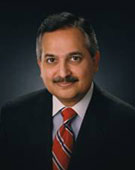Sutherland Global Services was involved in business process outsourcing long before the term became widely known. Headquartered in Rochester, N.Y., Sutherland Global has 22,000 employees and operations in seven countries, including India, the Philippines, Canada, Mexico and Bulgaria. In the following interview, India Knowledge at Wharton and Ravi Aron, a senior fellow at Wharton’s Mack Center for Emerging Technologies, spoke with Dilip R. Vellodi, CEO of Sutherland Global Services, about the company’s business model and its future.
The following is an edited transcript:
Ravi Aron: One of the interesting things we noticed about Sutherland is your expansion path, which ties into your history. Unlike companies that traditionally take the IPO route, raising a combination of debt and equity, you organically grew for a long while, and then Oak Partners and Standard Chartered took a venture-capital position in your firm, or a private-equity position. Tell us about that decision and how it ties into Sutherland’s history.
Dilip Vellodi: We had been in business for 17 to 18 years before Oak came on board. We came into being in 1986, when the term “business process outsourcing” was not on the horizon. In fact, we called ourselves a “customer management company.”
The seeds for this were sown during my days at Xerox. We had a group called “market development,” which was pretty much everything other than the direct sales force. The idea behind this group was to get products to market below a certain price point, in an efficient and relatively fast manner, and to help increase the productivity of the direct sales force. We started off as a skunk works inside of Xerox and then grew on, and over a three- to four-year period, we ended up being a successful organization. I absolutely felt that if Xerox had a need for those kinds of services, there would be a need for similar services by other companies. That is really how Sutherland got started.
We had no clients, but a very clear concept, a very clear vision of what this entity was going to be, and the mission statement was clearly written up before we opened our doors. That mission statement has remained unchanged over the last … we are coming up on 22 years. The mission statement essentially reads that we would drive efficiency and productivity to help increase the customer lifetime value of our clients and their competitive advantage while we deliver measurable results. We hung our hat on those two words — “measurable results.” That went a long way in terms of us building our client base.
The values on which we would run this company were also written before we opened our doors. One that was clearly defined was this whole notion of entrepreneurship. There were other values, integrity being the overarching one. I believe these values have stayed at Sutherland, although as we grow it becomes more challenging to get each and every employee completely aligned. But that is a challenge worth pursuing.
I give you this background because the manner in which this company was formed, the vision we had, the mission we were going to undertake, which has remained unchanged, is part of the reason we remained the way we did for that many years.
Looking back as CEO, I have asked myself this question: If I were to do it all over again, would I change anything? We would have gone out and gotten the funding a little earlier. But not too much earlier, because the whole concept of bootstrapping and watching your cost, investing when needed, servicing your clients, making sure that you not only meet but exceed client expectations, ensuring that you deliver results … that is the only way you are going to keep the company up and running and growing. All of those elements are part and parcel of the DNA of this company.
When we decided to bring in outside funding it was because we had seen the market for these services starting to explode. And given that it is a very capital-intensive business, we felt it was time to tap into outside capital. It was as simple as that. We were very clear that we saw capital as a commodity, so we wanted to make sure we partnered with those who would be aligned with the objectives and the values of the company. And that they would in turn help open up markets and help bring talent to the table. That is how we brought in Oak. And Oak is an entity that has invested in companies at various stages of a company’s life cycle, so pretty much stage-independent. They have turned out to be a wonderful partner.
The Sutherland model is a pretty well-balanced global delivery model, where approximately half of our revenues are delivered from North America and South America with the other half coming from Asia-Pacific. We felt it was important to have a partner on that side of the world, if you will, and that is how, two years ago, Standard Chartered came on board. And again, [it is] a wonderful partner, and they are both in it for the long haul. We have been running a marathon, so we do not believe in taking shortcuts, and we have two partners who have bought into it. I think we have done a decent job of giving them a healthy return.
Aron: You mentioned that you were delivering services before the term BPO even existed. But Sutherland is not your traditional BPO company from the many projects and initiatives I have read and data that your colleagues have shared with me. The industry tends to look at some artificial categories such as “we only do voice, we only do transaction processing,” little splinters here and there. But Sutherland’s philosophy is different. You speak about business performance improvements.
Vellodi: When we started off, we started with process consulting. Why process consulting? From a very practical standpoint, it did not require a whole lot of money to get started. But we also wanted to distinguish that from general consulting. We were not planning on, nor could we compete with, some of the consulting heavyweights of those days.
We were very clear in that, on any advice we provided, we were going to work with our clients in terms of executing those ideas in order to deliver results. We also said we were going to play all along our client’s customer life cycle. That meant identifying prospects on their behalf, helping those prospects be converted to customers, retaining and maintaining those customers, providing services to those customers at the back end. That is how we got started.
Over time we have evolved to a point where we provide these services, not as point solutions, but in an integrated manner. We have two categories of services. We call the first Customer Lifecycle Management services. This has to do with all the touch points related to our clients’ customers, and with the revenue side of our clients’ P&L. We then have Back-office Lifecycle Management services, which have to do with the cost side of the P&L, the expense side.
We offer this to our clients in an integrated manner which we refer to as integrated BPO. The idea is not just about reducing costs. It has to do with driving business performance improvement. It has to do with helping our clients transform their processes in a manner where true value is being delivered.
India Knowledge at Wharton: You have referred to measurable results. Could you, without naming your client, give an example of a process that you were able to improve upon, both on the revenue side and the cost side?
Vellodi: Let me back up a little and talk about this notion of what we refer to as value pricing, and then I will come to your question. Different pricing models exist in this space. You have manpower-based pricing. You have time-based pricing. Both of those do not quite lend themselves to this notion of business performance improvement. On the other hand, you have pricing models that are event-based, transaction-based or total-solutions-based.
In order to get paid based on an outcome you need a client who is willing to partner with you on that front … because it has to be a true partnership. Otherwise, pricing based on performance will not work. But what this partnership and this mode of operation and contracting does is move you from a transactional outsourcing model to a strategic outsourcing model. That is what we at Sutherland believe needs to happen to drive performance improvement.
Having said that, I will give you an example in the technology space where we have a client, one of the leading providers of antivirus software. We started off as a single-solution provider to a certain need they had, and over time it has evolved into a very strategic partnership.
We have helped them transform their support services from a cost-based initiative to one where we have helped create revenue opportunities, where we then have gone on to share in those revenue opportunities based on the outcome, where we are now applying advanced predictive analytics to further improve performance. To us, this is transformational. This is very much a strategic partnership.
We have other partnerships, say, in the mortgage processing area, where we are paid based not just on the number of events that take place but on the mortgages that are actually closed. And we, in turn, are responsible for the fatal errors as well, so it is a double-edged sword. But again, a wonderful partnership, and the key here is one has to truly understand the client’s business. You have to have a partnership model and you have to have the analytical ability to get behind the information and predict outcomes, along with having sound processes and the technological platforms to drive efficiency and productivity.
Aron: The industry seems to very often speak in terms of core versus non-core. What kind of criteria would you place before large corporations and say this is the logic for outsourcing or offshoring a process?
Vellodi: This notion of core versus non-core as it is related to business process outsourcing and of outsourcing non-core processes made sense when companies were just looking to reduce costs. In the integrated BPO model, those lines get blurred. Earlier I had given you examples of a couple of our clients, and going back to those examples, they were really about driving channels of revenue. Then it becomes very core, and those processes can be outsourced.
So no more is outsourcing going to be based on core versus non-core areas. It is going to be more a function of how the outsourcing arrangement is set up so that it can lead to a strategic partnership and true process improvement that will drive efficiency, or productivity on one hand, and could create revenue opportunities on the other.
Aron: In this scenario, what role do your offshore operations play? What do your offshore folks do and why do you locate in those locations?
Vellodi: Before I get to your question … Earlier you had talked about transaction processing and voice processing and non-voice processing. In the Sutherland model of integrated business process outsourcing solutions we do not make any distinction between transaction versus voice versus non-voice because our clients are not buying services based on a voice- or a non-voice- or a transaction-based approach. They are buying a solution or you are offering them a solution. In the same manner, we do not make too much of a distinction between onshore versus offshore.
What we have created is a global blended delivery model. When we go into a geographic region we look at a few key elements. Sure, there is the advantage of labor arbitrage that is available. But that is more transient. In fact, as we have recently seen, just a few heavy blips in the currency equation could wipe those away. Those are not sustainable advantages.
When we go into a geographic region we see if it has a good, healthy scalable pool of talent. Number two, is the infrastructure robust enough? Number three, is the economic climate stable, is the political climate stable, and is it a business-friendly environment? Having said that, we are a U.S.-based company; we started in Rochester, N.Y., in 1986-87. When we looked at offshore locations, India was the most promising because of the sheer scale of talent that was available. … The infrastructure was ready, and in 2001 we made the decision to invest in India. We started generating revenues out of India in January 2002. It is interesting because toward the tail end of 2001 the U.S. economy had gone through a major slide. It was not as severe as the one we are faced with today, but we had already made our decision to go to India, based on the factors I outlined earlier. We had a strategic view of where we needed to locate our service delivery centers. After we set up in India, we came back West and created near-shore delivery centers in Canada.
We then went back East, created redundancy to India in the Philippines, came back West again, created our Latin American operations to tap into the Spanish market, which is a growing segment. Now we have gone back and set up our Eastern European operations in Bulgaria. We call it RightSourcing at Sutherland. It has to do with leveraging the best talent around the globe to provide a global blended delivery model.
If I could use an example, we have a client that is a leading provider of software for the tax market. Ours is a strategic partnership that has evolved over the years. This is a company where we deliver services out of multiple geographic regions, supporting multiple initiatives. If technical support is needed for some of their products, that could be provided out of India; a financial advisory role could be played out of the United States or Canada; support services might be more conducive to being provided out of the Philippines because of the way in which they might engage with the end-user/customer while the end-user/customer might be, say, uploading their tax statements. More than 80% of our clients buy multiple services from multiple geographies.
India Knowledge at Wharton: You referred to the economic slowdown. What effect has that had on your clients? Because of the financial crisis, are they holding back on spending, because they are not sure what is happening, or are they demanding more of your services because they would like to become more efficient and reduce costs?
Vellodi: It is a little too early to tell. Right now most people are shell-shocked. But we do have a sense of how this will play out, and that is the scenario we are deploying in terms of our planning. If you take a look at the business process outsourcing arena, we believe that it is a sizable marketplace opportunity. Even if you take all the numbers that are being bantered around, slash it by 50% and then say what is addressable is another 50% of that, you still are talking about a fairly large opportunity.
We believe that it is going to continue to grow at about 8% to 10% annually. In the short term, there will be incredible pressure for obvious reasons both on the revenue side and the expense side. We believe the expense side will spring forward immediately and then there will be pressure on the revenue side.
We are well-positioned in terms of providing an integrated solution to capture those opportunities. By the same token, there will be a lag because we are seeing a lot of decisions getting delayed. But those decisions will have to be made in short order because now more than ever all the things we talked about — efficiency, productivity, driving results — will become paramount.
From our company’s perspective, we have not seen any drastic slowdown. In fact this year, we expect to finish up with growth of a little over 25%. And we are making sure we continue to invest. Just like other companies are feeling the pinch, we are preparing for it as well. We have gone through several similar business cycles before, and this time around we are better prepared. We are doing all the belt-tightening we need to do. We need to be a lot sharper than the clients we service on that front. By the same token, we are investing in some of the services which should drive incremental business to capture what is today a challenge but could be an opportunity.
Aron: So your model presupposes that you will be able to absorb a process from a client, clean it up, and deliver business performance improvement, which means you have to outperform the client’s in-house operations. What makes you think Sutherland can do this?
Vellodi: For starters, we have been at this for 22 years; 84% of our revenues come from the Fortune 1000 space, a challenging space to crack open, to work within. But we have been able to effectively work inside this arena because of the manner in which we have been able to refine our processes over time; the manner in which we have been able to deploy technology; the effective utilization of the technological innovations and products that we have built in-house to drive efficiency and productivity; the manner in which we have evolved our services where we have brought in this notion of integrated business process outsourcing; the global blended service delivery model. Put all of these together and we believe we have a good combination of processes, technology, and combine that with the global leadership team — which is truly global, culturally very well-meshed, and operationally very effective — and you have the ingredients for why we believe we could partner effectively with our clients.
Aron: A very short follow-up would be your strategic basis of differentiation. To use a colloquialism, what is your secret sauce that helps you differentiate yourself?
Vellodi: I believe it has to do with our genesis. It has to do with the fact that we have been a pure-play business process outsourcing entity for the last 22 years and we have stayed the course. You take a look at the technological backbone, the processes that we have created; the engagement model; the integrated business process outsourcing model on which we engage with our clients; our global blended delivery model; and, most important, our global leadership team. The manner in which we have embedded services inside of our offerings, be it the analytical services that we now refer to as Smart.BPO or the manner in which we help the transformation process from transaction outsourcing to strategic outsourcing are key ingredients that differentiate us in the marketplace.
Aron: About 46% of your revenues come from Fortune 50 companies. What other industries are you looking to enter? Where do you see yourself going? Telecom is a big one right now, but what are the other verticals you are interested in?
Vellodi: Over the years we have been very focused on the verticals that we service. We have also deployed what we refer to as this concept of adjacency, where once we have the processes down and once we have our technology platforms in place, we essentially leverage those processes and platforms to get into adjacent areas or opportunities. That is how we have moved from technology to telecom, then into e-retail, the BFSI (banking, financial services and insurance) space, and now into the healthcare arena.
As we look at the economic environment today and the changes taking place, we believe the U.S. government space offers us a major opportunity. We have a team looking to see how we can deploy our services in that sector. These are some of the initiatives we have under way. Our success in all of these will essentially be a function of how well we execute, and I think that is where the effectiveness of our global leadership team comes into play.



